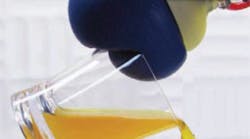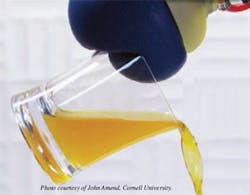For years, robot designers have wrestled with the challenge of developing a gripper that duplicates the versatility of the human hand and fingers. Researchers from Cornell University, the University of Chicago, and iRobot Corp. took a different approach to this problem — and created a versatile gripper that uses everyday ground coffee and a latex party balloon! They call it a universal gripper because it conforms to the object it’s grabbing, rather than being designed to grip a particular object.
In operation, the coffee-filled balloon is pressed against the desired object so that it deforms around it. Then a vacuum sucks the air out of the balloon and its grip solidifies. When the vacuum is released, the balloon becomes soft again and the gripper lets go. The secret: coffee is a particulate material that is characterized by large aggregates of individually solid particles. Particulate materials have a so-called “jamming transition,” which turns their behavior from fluidlike to solidlike when the particles can no longer slide past each other. (This phenomenon is familiar to anyone who has ever bought vacuum-packed coffee — it’s hard as a brick until the package is unsealed.) Ground coffee grains are like a series of small gears. When they are not pressed together, they can roll over each other and flow. When they are pressed together just a little bit, the teeth interlock, and they act like a solid. Coffee worked well during the experiments because it jams well (it has a wide difference between its hardest and softest states). And of course, coffee also is lightweight and cheap.
The team used several different vacuum sources — including embedded pumps, off-board pumps, venturi pumps, and vacuum reservoir tanks — in prototype tests with equal success. Typically the gripper became rigid enough to grasp an object when the pressure inside reached 85 kPa below atmosphere.
Appeared in print in the May 2011 issue as "Coffee gets a grip"


